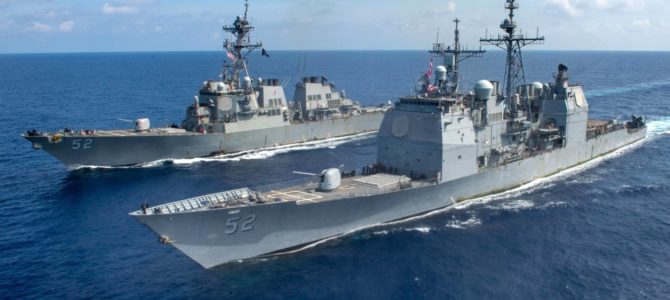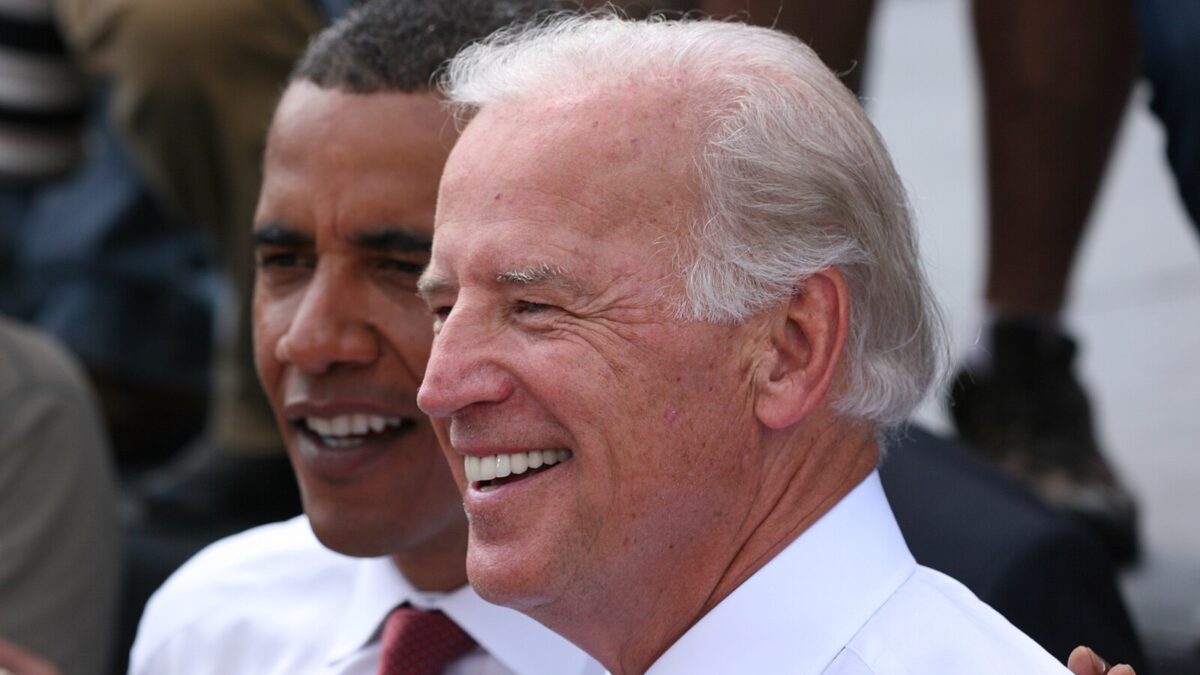
When Secretary of State Mike Pompeo declared a significant U.S. foreign policy shift in the South China Sea on July 13, it stirred up both hope and fear in the region. The South China Sea is a geographically strategic body of water in Southeast Asia, surrounded by several countries that include China, Vietnam, and the Philippines.
At the heart of the South China Sea dispute is the “nine-dash line,” a virtual boundary Beijing created that encircles nearly 90 percent of the contested waters. The line stretches as far as 1,200 miles from mainland China to within 100 miles off the coasts of the Philippines, Malaysia, and Vietnam. Beijing maintains it owns any land or features contained within the line as part of its vaguely defined “historical maritime rights.”
Neighboring countries, however, reject Beijing’s claims in the region and believe they have competing historical rights. They maintain these rights are backed by the United Nations Convention on the Law of the Sea, which states a nation has sovereignty over waters extending 12 nautical miles from its land and exclusive control over economic activities 200 nautical miles out. China is a signatory of this treaty.
Between the 1970s to the mid-’80s, Vietnam lost control of Paracels Island to China after fighting two wars. In 1996, the Chinese navy engaged in a battle with the Philippine navy near Capones Island in the Mischief Reef, one of the Spratly Islands still claimed by Manila. Today, China claims almost the entirety of the Spratly Islands territory as its own.
The Value of the South China Sea
The disputes between China and its neighboring Asian countries are about economic rights as much as they are about who has the rightful historical claim. It is estimated that the South China Sea region is rich with deposits of oil, gas, and minerals. Some estimate the region contains between 11 to 22 billion barrels of oil, 190-290 trillion cubic feet of natural gas, and accounts for 10 percent of the world’s fisheries. Furthermore, the area is one of the busiest trading routes and provides food and a way of living for millions of people.
The trade route through the South China Sea is critical to economies in Taiwan, Japan, and South Korea, but especially to China. As pointed out by the Center for Strategic and International Studies, a Washington, D.C.-based think tank, about $3.4 trillion worth of global trade, as well as a third of global shipping, passes through the South China Sea area.
“As the second-largest economy in the world with over 60 percent of its trade in value traveling by sea,” CSIS notes, “China’s economic security is closely tied to the South China Sea.” So China’s dependency on natural resources and trade amplifies the geographic importance of the South China Sea.
In 2010, China’s foreign minister told his counterparts that “China is a big country and other countries are small countries and that is just a fact.” In other words, Beijing views international affairs as the law of the jungle — might makes right.
China’s smaller neighbors began to suffer Beijing’s relentless bullying. In 2011, a Chinese surveillance ship forced a Philippine ship conducting surveys in the Reed Bank. Later that year, Vietnam alleged that Chinese ships harassed its oil exploration ships in the South China Sea.
After Xi Jinping became Communist China’s supreme leader, China started land reclamation efforts in the South China Sea in 2013, a move Xi believes necessary to expand China’s strategic interests and help turn the nation into a maritime power. China gradually tightened its grasp over the region while evaluating reaction from the United States.
Failing to Check China’s Ambitions
When it became clear that U.S. President Barack Obama, wouldn’t take proactive measures to push back, Beijing ramped up its island-building activities. Even Obama’s defense secretary, Ash Carter, criticized that Obama’s soft approach toward China gave the communist regime a rare strategic opening for its fanatic island-building schemes.
In 2013, the Philippines filed an arbitration case under the UN Convention on the Law of the Sea over China’s claims of sovereignty to the Spratly Islands and Scarborough Shoal. Beijing arrogantly rejected the merit of the Philippines’s case and refused to participate in any legal proceedings.
While the Obama administration was idly standing by — to the great annoyance and alarm of its Southeast Asian neighbors — China was able to reclaim more than 3,200 acres of land in the South China Sea. By 2015, it was too late for the United States to effectively intervene to stop China’s expansion in the South China Sea.
Indeed, China insisted its land reclamation efforts were for peaceful purposes, such as fishing and energy exploration, and promised to commit to “non-militarization” of the territory in question. Satellite images, however, show there is an abundance of runways, ports, aircraft hangars, radars, sensor equipment, and military buildings on these man-made islands.
In 2016, the Permanent Court of Arbitration in the Hague ruled that “there was no legal basis for China to claim historic rights to resources within the sea areas falling within its ‘nine-dash line’ — an area encompassing the vast majority of the South China Sea.” The court stated that China’s island build-up was not only unlawful, but a blatant violation of the economic rights of the Philippines, and that it “caused severe environmental harm to reefs in the chain.”
Infuriated with the ruling, Beijing chose to simply ignore it, pressing forward with more island constructions and militarization. While the United States kept sending Navy ships through the South China Sea to maintain freedom of navigation, the official U.S. policy in the South China Sea had always been to remain neutral to all sides. With no country powerful enough to enforce the UN ruling, the policy became a meaningless piece of paper.
Now, even amid the COVID-19 pandemic, China is continuing its aggression in the South China Sea. On April 3, 2020, a Chinese coast guard ship collided with a Vietnamese fishing boat near the Paracel Islands and captured the boat’s eight crew members and two additional fishing boats that came to its rescue. Beijing blamed the Vietnamese fishing boat for intruding into China’s territory and causing the incident.
In truth, the Vietnamese were fishing in their own internationally recognized exclusive economic zone. Chinese coast guard ships and fishing boats, however, frequently travel illegally inside the exclusive economic zones of other countries in the South China Sea, often harassing fishermen and oil drilling operations
Resisting Further Aggression
Shortly after this incident, a Chinese government-owned scientific exploration ship, protected by heavily guarded coast guard vessels, was reportedly surveying the sea bed in Vietnam’s exclusive economic zone and later tagging an exploration vessel belonging to Malaysia’s state oil company in Malaysia’s exclusive economic zone. Beijing also announced in April that it created two administrative districts to manage affairs in the region.
The days of Beijing’s unrestricted and unchallenged expansion in the South China Sea came to an end, however, in July 2020. When China recently held a large military exercise around the Paracel Islands in the South China Sea, the U.S. Navy sent two aircraft carriers to nearby water and held a military drill of its own.
Then, on July 13, U.S. Secretary of State Mike Pompeo announced that the United States formally opposes several of Beijing’s claims in the South China Sea, stating, “Beijing’s claims to offshore resources across most of the South China Sea are completely unlawful, as is its campaign of bullying to control them.”
Pompeo remarked that this shift, from remaining in neutrality to calling out Beijing directly, was necessary to uphold international law, especially in light of the 2016 UN tribunal ruling that prevents China from bullying its neighbors and treating the South China Sea as its “maritime empire.” This new policy, along with a greater military presence in the South China Sea, suggests the United States has finally taken a tougher and more directly confrontational approach to curbing China’s ambitions in the region.
For China’s much smaller neighbors in the region, this U.S. decisionconjures mixed emotions. They feel relieved that they do not have to endure Beijing’s bullying anymore because of U.S. support. Conversely, Beijing has proven its comfort with playing offense on the international stage.
Secretary Xi has staked his credibility within the Chinese Communist Party on China’s South China Sea claims — backing down would be political suicide. But make no mistake: Washington’s new policy will infuriate Beijing and increase tensions between the two nations. These tensions may lead to an accident or a collision between the U.S. Navy and China’s Navy, thereby triggering a military confrontation between the two superpowers.
We already had a close call in September 2018, when the USS Decatur sailed close to the Spratly Islands and China sent a destroyer to demand the U.S. ship either change course or “suffer consequences.” Reportedly, the two ships were “as close as 45 yards from each other, prompting calls that rules for navy encounters should be amended as the risk of confrontation between the two militaries was rising.” In March 2020, the Chinese navy conducted an anti-submarine drill over the South China Sea, clearly in preparation for possible military conflict against the United States.
It should concern all of us that if China keeps pushing the limits of its aggressive tactics, a military confrontation may become unavoidable. At least one defense expert, Robert Farley, has predicted that the first real Sino-U.S. war could be fought in the South China Sea. Let’s hope that will never happen.









